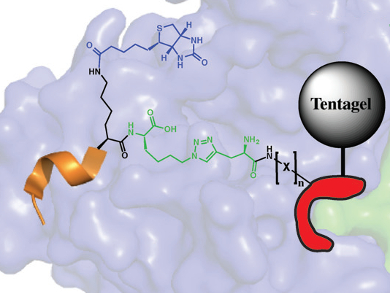Botulinum Neurotoxin A Inhibitor Developed
Botulinum toxin produced by the bacterium Clostridium botulinum is one of the most potent toxins known to humankind – despite its astonishing career in cosmetics applications to prevent development of wrinkles by paralyzing facial muscles. Developing potent antidotes to the toxin is extremely challenging.
American scientists have managed to design a fully synthetic inhibitor to the BoNT/A protein by both rationalizing the cell entrance mechanism of BoNT and making use of the click chemistry approach. This intriguing and successful design is presented in the journal Angewandte Chemie.
Bioweapon and Cosmetic Agent
BoNT/A acts as a protease, cleaving the protein that prevents neurotransmitter release in neuronal cells. The muscles no longer get information from the neurons, and relax. Botulism caused by Clostridium infection can be deadly, especially for infants. On the other hand, very tiny doses of BoNT toxins are applied for the treatment of movement disorders as well as for aesthetic corrections. As for its toxicity, overdosing or wrong application may have severe effects.
The team of James R. Heath, California Institute of Technology (Caltech), Pasadena, CA, USA, in collaboration with Indi Molecular, Culver City, CA, USA, has successfully exploited the cell entry machinery of BoNT/A for the development of a new drug candidate that specifically targets the protease mechanism.
All-Synthetic Click Epitope Targeting Chemistry
“To build a BoNT inhibitor, we sought to further generalize the target-guided synthesis approach by exploiting the tertiary structure of the BoNT light chain as a landscape for assembling a potent inhibitor”, the authors write. They constructed a biligand inhibitor, one part of it mimicking the natural peptide substrate and the other part binding selectively to a nearby unstructured epitope on the protein surface. Both parts were then joined by a linker made of amino acids that were screened and assembled by in situ protein-catalyzed click technology.
The as-synthesized inhibitor, named Inh-2, is able to knock out the protein the moment it discloses itself inside the cell. It attaches to the toxin surface with its epitope-targeted part and thus transforms the toxin into a Trojan horse as it is carried into the cell together with its target. Inh-2 worked well in assays and on whole live neurons. It has therefore great potential to give a new possible antidote approach to level off unwanted side effects of Botox use – be it in medical applications or the outcome of a failed Botox party.
- Epitope Targeting of Tertiary Protein Structure Enables Target-Guided Synthesis of a Potent In-Cell Inhibitor of Botulinum Neurotoxin,
Blake Farrow, Michelle Wong, Jacquie Malette, Bert Lai, Kaycie M. Deyle, Samir Das, Arundhati Nag, Heather D. Agnew, James R. Heath,
Angew. Chem. Int. Ed. 2015, 54, 7114–7119.
DOI: 10.1002/anie.201502451




